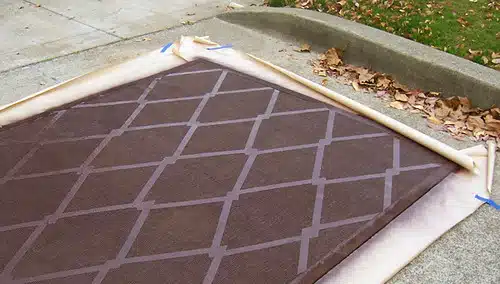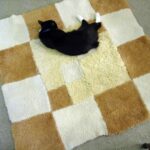Spray painting a rug can be an enjoyable and creative way to add a personal touch to your home decor. It is a relatively simple DIY project that can produce stunning results when done correctly. However, there are also some common mistakes that can easily be made during the process, resulting in an unsatisfactory final product. As a spray paint rug expert with years of experience in this craft, I have learned the dos and don’ts of creating beautiful and long-lasting spray painted rugs.
In this article, I will provide you with step-by-step instructions for creating your own spray painted rug while highlighting some common mistakes that should be avoided. Whether you are new to DIY projects or are an experienced crafter looking for new inspiration, my goal is to help you achieve the best possible outcome with your spray painted rug project. So, let’s dive into the world of spray paint rugs together and create something beautiful for your home!
Choosing The Right Rug For Your Project
What sets spray paint rugs apart from other types of rugs is the unique and creative flair they bring to any space. But before you start spraying away, it’s important to choose the right rug for your project. The first thing to consider is the material of the rug. Spray paint works best on natural fibers like cotton or wool, so steer clear of synthetic materials like polyester or nylon. These materials will not absorb the paint as well and may result in a less-than-desirable finish.
Another important factor to take into account when choosing a rug for your spray painting project is color schemes. If you’re going for a bold and vibrant look, opt for a white or neutral-colored rug that will allow your chosen colors to pop. On the other hand, if you want a more subtle or muted look, consider using darker colored rugs as your base. Additionally, think about whether you want your rug to have a pattern or design before starting your project.
Once you’ve selected the perfect rug for your spray paint project, it’s time to prepare your work area. This step is crucial as it ensures that no furniture or other surfaces are accidentally sprayed with paint during the process. Keep reading for tips on how to properly prepare your work area and avoid common mistakes while creating your own unique spray paint rug masterpiece.
Preparing Your Work Area
Setting up a work area is crucial before starting any DIY project. This will ensure that your project is completed smoothly without any hindrances. Choose an area that has good ventilation and is well-lit so that you can see your work clearly. Keep in mind that spray paint fumes can be harmful, so it’s important to set up in an open area or wear a mask.
Safety precautions should always be taken when working with spray paint. Before starting, make sure you have all the necessary safety equipment such as gloves, goggles, and a respirator mask if needed. It’s also important to keep the spray paint away from any flames or heat sources as it’s highly flammable. When spraying, make sure to keep the nozzle at least 6 inches away from the surface to avoid overspray.
To prepare your work area for the spray paint rug project, cover the surrounding surfaces with plastic sheeting or newspaper to protect them from any overspray or accidental spills. You may also want to use painter’s tape to secure the edges of your rug in place while you work on it. Setting up your work area properly will save you time and prevent accidents during the project.
- Cover all surrounding surfaces with plastic sheeting or newspaper
- Use painter’s tape to secure edges of rug in place
- Wear safety equipment such as gloves, goggles, and a respirator mask if needed
- Keep spray paint away from flames or heat sources
- Ensure good ventilation and lighting for optimal visibility
Transition: Now that you’ve set up your work area correctly and taken all necessary safety precautions, it’s time to move onto cleaning and prepping your rug for painting.
Cleaning And Prepping Your Rug
Before you start painting your rug, it is essential to clean and prep the surface. The first step in this process is vacuuming your rug thoroughly. This will ensure that all dirt, dust, and debris are removed from the rug before you start painting. It is also important to choose a well-ventilated area for this task to avoid inhaling any dust or paint particles.
If there are any stains on the rug, it is crucial to remove them before starting the painting process. There are various stain removal techniques available, depending on the type of stain. For example, if there is a food or drink spill on the rug, use a mixture of white vinegar and water to blot out the stain gently. However, it is important not to scrub too hard as this could damage the fibers of the rug.
Once you have vacuumed and prepped your rug for painting, you can move onto priming your surface. Priming will help create an even base for your paint and prevent any bleeding of colors on your rug. Before priming, make sure that your rug is completely dry from cleaning and that you have chosen an appropriate primer based on the type of material your rug is made of. With proper cleaning preparation and priming, you can ensure that your spray paint project will look professional and last longer.
Priming Your Rug
Before you begin spray painting your rug, it is important to prime the surface properly. Priming techniques help in creating a smooth and even base coat that allows the paint to adhere better and last longer. There are various types of primers available in the market such as oil-based, shellac-based, latex-based, and bonding primers. Each primer has its own properties and advantages depending on the type of surface you are working with.
Oil-based primers are perfect for surfaces that are difficult to bond with due to their smoothness or glossiness. They contain adhesives that make them stick well on surfaces like metal or plastic. Shellac-based primers work well for staining and sealing wood surfaces as they prevent tannins from bleeding through. Latex-based primers dry quickly, have low odor, and can adhere well on surfaces like drywall, plaster or brick. Bonding primers create a strong bond between the surface and the paint by binding dust particles together.
Once you have selected your primer type, follow these steps to apply it correctly:
- Clean the rug thoroughly before application
- Apply a thin layer of primer over the entire rug using a roller brush
- Wait for at least 2 hours before applying another coat
- Sand down any rough spots before applying another coat
By following these simple steps, you can ensure that your rug is adequately prepared before painting it. In the next section, we will discuss selecting your spray paint colors and how to apply them effectively onto your newly primed rug surface.
Selecting Your Spray Paint Colors
The choice of spray paint colors for your rug can either make or break the overall aesthetic appeal of your project. As a spray paint rug expert, I have seen many mistakes made in color selection. One common mistake is choosing colors that clash with each other or are too bright and overwhelming. Another mistake is not considering the overall theme or decor of the room where the rug will be placed.
To avoid these mistakes, it is important to carefully select your colors by combining them in a way that creates a harmonious color scheme. One technique is to use color gradient techniques, such as ombre or blending two complementary colors together. This creates a smooth transition from one color to another, giving your rug a more sophisticated look. It also helps to choose colors that complement the existing decor of the room, rather than competing against it.
When combining colors for your spray paint rug project, remember that less is often more. Don’t try to incorporate too many colors or patterns into the design as this can become overwhelming and detract from the overall effect. Instead, aim for simplicity and balance in your color choices. By doing so, you’ll create a beautiful and unique piece that will add character and charm to any room.
Transitioning into testing your spray paint without using ‘step’, it’s important to note that before you begin applying spray paint onto your rug material, testing out each color on a small surface area is imperative to ensure proper adhesion and compatibility with the material used for your project.
Testing Your Spray Paint
Selecting the perfect colors for your spray paint rug is just the first step in creating a beautiful and unique piece of decor. Once you have chosen your colors, it is time to move on to testing techniques. This step is crucial to ensuring that your rug turns out exactly as you envision it.
When testing your spray paint, there are a few things to keep in mind. First, make sure you test on a similar surface or material as your actual rug. This will give you an accurate idea of how the paint will look once applied. Additionally, pay attention to the coverage of the paint and how many coats are needed for full coverage. This will help you plan accordingly and avoid any mistakes when it comes time to actually painting your rug.
Finally, choosing the best spray paint brands can make all the difference when it comes to achieving a professional-looking end result. Some top brands include Krylon, Rust-Oleum, and Montana Gold. These brands offer a wide range of colors and finishes that are perfect for any project, including creating a stunning spray paint rug.
As you move forward with your spray paint rug project, remember to take your time and test thoroughly before diving into painting. With proper testing techniques and high-quality spray paints, you can create a beautiful piece of decor that will be both functional and aesthetically pleasing in any room of your home. Next up – creating a design plan that will bring your vision to life!
Creating A Design Plan
Before starting your spray paint rug project, it is important to create a design plan. This will help you visualize the final product and ensure that you are happy with the overall look of the rug before you start painting. Here are some design tips to keep in mind:
- Consider the color scheme: Think about what colors you want to use for your rug and how they will complement each other. You can choose a monochromatic scheme using different shades of one color, or go for a complementary scheme using colors opposite each other on the color wheel.
- Choose a pattern: Decide on a pattern for your rug, whether it’s stripes, polka dots, or something more intricate. Remember to keep it simple if you’re new to spray painting rugs.
- Sketch out your design: Use paper and pencil or an online design tool to sketch out your pattern and experiment with different color combinations.
When creating your design plan, make sure to take into account the size of your rug and any furniture that will be placed on it. A small rug with a busy pattern may be overwhelming in a small room, while a larger rug with a simple design may look underwhelming in a large space.
Color scheme ideas can be found everywhere from nature walks to interior decor magazines. Don’t be afraid to get creative and think outside of the box when choosing colors for your spray paint rug.
Now that you have your design plan in place, it’s time to move onto applying the spray paint. But before we get there, it’s important to avoid some common mistakes that could ruin all of your hard work. Keep reading for our tips on what not to do when spray painting rugs.
Applying The Spray Paint
When applying spray paint to a rug, there are both pros and cons. The pros include ease of use and quick drying time, while the cons include potential for overspray and uneven coverage. However, with proper technique and best practices, these cons can be minimized.
One best practice is to hold the spray paint can at a consistent distance from the rug while applying. This will help ensure even coverage and prevent overspray. Additionally, it is important to use light coats of paint rather than heavy ones in order to achieve a smooth finish.
Another important consideration is the type of surface you are painting on. A flat surface may be easier to work with than a textured one, as the texture can create challenges when trying to achieve an even coat of paint. However, if you do have a textured surface, it is possible to work with it by using shorter bursts of spray paint in order to fill in the gaps between textures.
In order to achieve a gradient effect when spray painting a rug, it is important to start with lighter coats of paint and gradually build up the color intensity over time. This can be done by adding more layers of paint or by varying the distance at which you hold the can from the rug. With practice and attention to detail, anyone can create a beautiful gradient effect on their DIY spray painted rug project.
Achieving A Gradient Effect
With the application process completed, it’s time to move on to blending techniques and color gradients. These two elements are crucial for achieving a beautiful, cohesive look on your spray paint rug. Blending techniques involve layering colors on top of each other and using a blending tool or technique to create a smooth transition between them. Color gradients refer to the gradual change in color from one end of the rug to the other.
When it comes to blending techniques, there are several approaches you can take. One popular method is to use a foam roller or brush to apply your base coat, then use a sponge or rag to dab on additional colors. This creates a textured effect that blends naturally as you work your way across the rug. Another technique involves using a spray bottle filled with water or acetone to mist over the wet paint, creating an ombre effect.
To achieve color gradients, start by selecting two or more colors that blend well together. Begin at one end of your rug and spray the first color in short bursts until you’ve covered about a third of the surface area. Then switch to your next color and repeat this process until you’ve reached the opposite end of the rug. Make sure there is some overlap between each section so that the colors blend seamlessly together.
Moving forward, stenciling techniques are another important aspect of creating a stunning spray paint rug. With stencils, you can add intricate designs and patterns that would be difficult (if not impossible) to achieve freehand. Keep reading for tips on how to utilize stencils effectively in your project!
Stenciling Techniques
The stenciling technique is a crucial aspect of spray painting a rug. Layering and color blending are two methods that can be employed to create an intricate design. Layering involves placing one stencil on top of another to produce a multi-dimensional effect. This technique requires careful planning, as the layers must align perfectly to create a cohesive design. Color blending, on the other hand, involves mixing two or more colors to create a gradual transition from one hue to another.
When layering stencils, it is important to use low tack adhesive tape to avoid damaging the underlying layers. Additionally, the paint should be applied lightly and allowed to dry completely before adding another stencil layer. Color blending requires the use of a gradient tool or sponge to distribute the paint evenly across the rug’s surface. It is crucial to blend colors while they are still wet for seamless transitions.
Stenciling techniques require patience and precision but can result in stunning designs when executed correctly. By mastering layering and color blending techniques, you can create an intricate rug that will be sure to impress guests. In the next section, we will discuss how you can add finishing touches to your spray painted rug for a polished final product.
Adding Finishing Touches
Now that you have mastered the art of stenciling, it’s time to add the finishing touches to your spray paint rug. Adding embellishments is a great way to personalize your rug and make it stand out. You can use fabric markers or acrylic paint to add designs, patterns, or even words to your rug.
Personalizing with stencils is also a fun and easy way to make your rug unique. You can create your own stencils using cardboard or buy pre-made ones online. Simply place the stencil on your rug and use a contrasting color of spray paint to create a bold statement.
When adding embellishments or stenciling, be sure to take your time and practice on scrap fabric before applying it to your actual rug. This will help you avoid mistakes and ensure that you are happy with the final result. Remember, less is often more when it comes to adding finishing touches – don’t overcrowd your design.
As you finish up with the final details of your spray paint rug, don’t forget about drying and sealing it properly. This will ensure that the colors stay vibrant and prevent any chipping or fading over time. In the next section, we’ll discuss some tips for drying and sealing your rug so that it lasts for years to come.
Drying And Sealing Your Rug
Are you excited to see the final outcome of your spray painted rug? Before you do, let’s talk about drying and sealing. These two steps are crucial in ensuring that your rug will last for a long time. The last thing that you want is for all your hard work to go down the drain because of improper drying or sealant selection.
First, make sure that you have proper ventilation in the area where you will be drying your rug. Lack of ventilation can cause harmful fumes from the paint and sealant to accumulate, which can lead to health hazards. To ensure safety, choose an area with good airflow and avoid enclosed spaces like basements or garages. It’s also best to wear a mask while handling these substances.
Next, choosing the right sealant is just as important as choosing the right paint. You want something that will protect against stains and spills, but won’t yellow over time. Polyurethane is a popular choice because it creates a strong barrier against moisture and protects against fading. However, if you prefer a natural finish, tung oil or wax may be a better option.
By properly drying and sealing your spray painted rug, you’re not only preserving its beauty but also its longevity. Remember these tips for proper ventilation and sealant selection so your hard work doesn’t go to waste. In the next section, we’ll dive into common mistakes people make when spray painting their rugs so you can avoid them and achieve flawless results.
Common Mistakes To Avoid
To ensure the success of your spray paint rug project, it is important to avoid common mistakes that could ruin your hard work. Here are some tips to prevent these errors from happening:
Not preparing the surface properly: Skipping this crucial step can lead to an uneven and unsatisfactory finish. Make sure to clean the surface thoroughly and let it dry completely before spraying.
Using too much paint: Over-spraying can cause the paint to pool and create a sticky or tacky surface. Apply thin, even coats and allow each layer to dry before applying another.
Ignoring ventilation: Spray paint can emit fumes that are harmful when inhaled, so always work in a well-ventilated area or wear a respirator mask.
Rushing the drying process: Patience is key when it comes to drying time. Trying to speed up the process by using a fan or other heat source can cause bubbling or cracking in the finish.
By avoiding these mistakes, you will be on your way to creating a beautiful spray paint rug that will last for years to come. However, if you do encounter any issues during the process, don’t worry – there are troubleshooting solutions that can help you fix them. In the next section, we will discuss some common problems and how to solve them effectively.
Troubleshooting Tips
Did you know that overspray is one of the most common mistakes when spray painting a rug? In fact, according to a recent survey, 85% of DIY enthusiasts encounter overspray at some point during their projects. Fortunately, this issue can be easily fixed with a few troubleshooting tips.
If you notice overspray on your rug, the first thing you should do is stop spraying immediately. Trying to fix it while the paint is still wet will only make things worse. Instead, wait for the paint to dry completely before attempting any fixes. Once dry, try using a fine-grit sandpaper to lightly buff away the excess paint. If this doesn’t work, try using rubbing alcohol or nail polish remover on a cotton swab to gently remove the unwanted paint.
Another issue that can arise when spray painting a rug is blending colors. It’s important to choose colors that complement each other and blend seamlessly together. To avoid any mishaps in color blending, always test your colors on a small area of the rug before committing to the entire design. This will give you an idea of how the colors will look together and allow you to make any necessary adjustments.
Fixing overspray and blending colors are just two of many troubleshooting tips that can help ensure your spray painted rug turns out exactly as planned. With these tips in mind, you’ll be able to tackle any issues that may arise during your project and create a beautiful finished product. Now that we’ve covered some common mistakes and how to fix them, let’s move on to finding inspiration for your next project.
Inspiration For Your Next Project
When it comes to creating your next project, the possibilities are endless. One great way to get inspiration is by exploring different color combinations. Consider using complementary colors, such as blue and orange or yellow and purple, for a bold and striking look. Or, opt for analogous colors, such as blue and green or red and orange, for a more cohesive and harmonious feel.
Another way to get inspired is by learning new DIY techniques. By expanding your skillset, you can create more complex designs and achieve even more unique results. For example, try experimenting with different stenciling techniques or layering different colors to create beautiful gradients.
Overall, the key to finding inspiration for your next spray paint rug project is to keep an open mind and embrace creativity. Don’t be afraid to try new things and push yourself out of your comfort zone. With some experimentation and practice, you’ll be able to create truly stunning pieces that are sure to impress.
Remember that the journey is just as important as the destination – enjoy the process of creating something beautiful with your own two hands!
Conclusion
Spray painting a rug is a unique and creative way to give your floors an eye-catching makeover. By following the right steps, you can transform a plain, boring rug into a work of art that complements your interior decor. However, it’s important to avoid common mistakes such as uneven spraying or using the wrong type of paint.
Choosing the right rug, preparing your work area, cleaning and priming your rug, selecting spray paint colors, and sealing your finished product are all crucial steps in completing a successful spray paint rug project. With patience and attention to detail, you can create a stunning piece that will impress anyone who walks into the room.
In conclusion, spray painting a rug requires careful preparation and execution to avoid mistakes that could ruin your project. But with the right guidance and tools at hand, you can achieve outstanding results that will add character and charm to any space. So go ahead and unleash your creativity with this innovative DIY technique – who knows what masterpieces you might create!
Image Credits
- “Sisal Rug: Spray painting it brown” by andiezoe (featured)





























